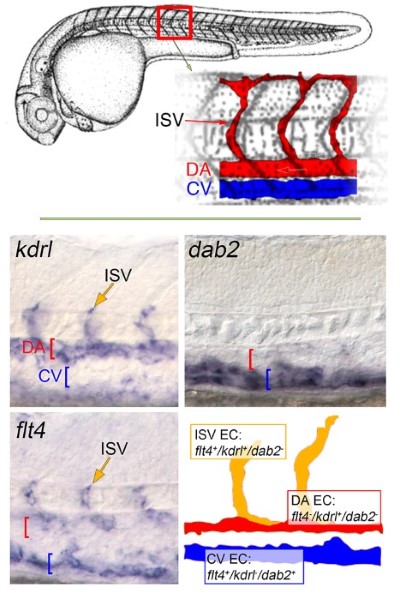Endothelial heterogeneity

The endothelial lining of blood vessels is a heterogenous population of cells. In adult organisms, this heterogeneity is important for the diverse functions of different vascular beds. In the developing embryo, we have found that endothelial heterogeneity is essential for vascular patterning. In particular, endothelial differentiation is important for establishing proper expression of guidance molecules and receptors important for vascular patterning. For example, during development of zebrafish trunk blood vessels (top panels), the receptors kdrl and flt4 display restricted expression - kdrl is expressed in intersegmental vessels (ISV) and the dorsal aorta (DA), while flt4 is only found in the cardinal vein (CV), as well as the ISVs. At the same time, other genes, such as dab2 are expressed only in the CV, but not in the DA or ISV. Thus, each developing vessel in this context displays a distinct identity during its development. Importantly, this diversity is reflected in the genetic requirement for kdrl and flt4. Kdrl is essential for DA development, while flt4 is important for vein formation; both act together to drive ISV development. Thus, early endothelial differentiation is essential to properly pattern the developing circulatory system.
Our current efforts are directed at better understanding how endothelial identities are established early in development. To this end, we are applying traditional lineage tracing approaches (e.g. Cre/lox and brainbow) coupled with cutting edge molecular approaches (e.g. ATAC-Seq and single-cell RNA-seq) to better understand when and how endothelial identities are established during development.
Lawson Lab publications relating to endothelial differentiation and morphogenesis
Sissaoui, S., Yu, J., Yan, A., Li, R., Yukselen, O., Kucukural, A., Zhu, L. J., Lawson, N. D. (2020) Genomic characterization of endothelial enhancers reveals a multifunctional role for NR2F2 in regulation of arteriovenous gene expression. Circulation Research, in press/on-line.
Quillien, A., Abdalla, M., Yu, J., Zhu, L. J., and Lawson, N. D. (2017) Robust identification of developmentally active endothelial enhancers in zebrafish using FANS-assisted ATAC-Seq. Cell Reports, 20:709-720.
Quillien, A., Moore, J. C., Shin, M., Siekmann, A. F., Smith, T., Pan, L., Moens, C. B., Parsons, M. J., Lawson, N. D. (2014) Distinct Notch signaling outputs pattern the developing arterial system. Development, 141:1544-1552
Siekmann, A.F., Standley, C., Fogarty, K. E., Wolfe, S. A., Lawson, N. D. (2009) Chemokine signaling guides regional patterning of the first embryonic artery. Genes and Development, 23:2272-2277.